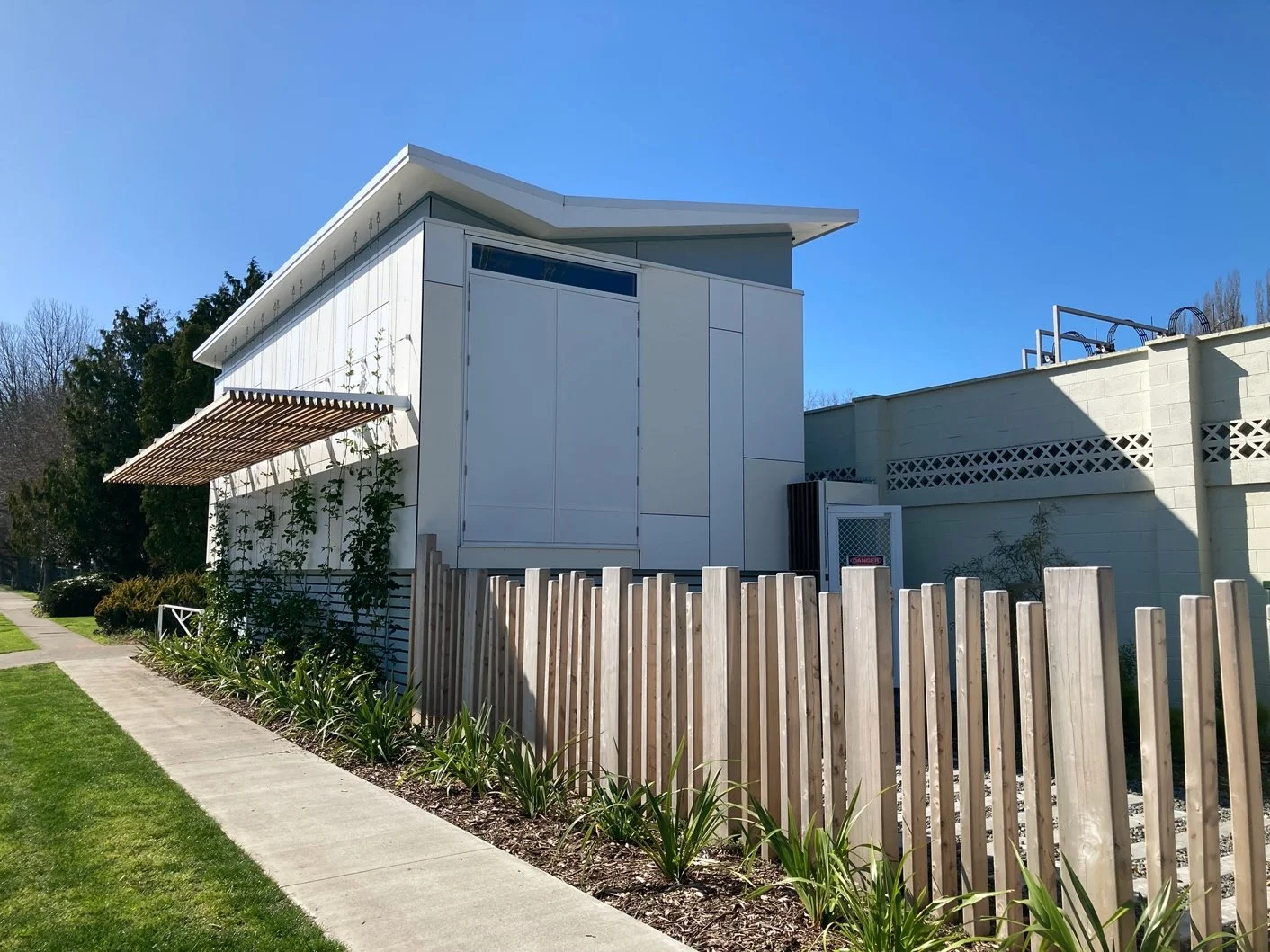Windsor substation: Living up to the sustainable challenge
Written by Charissa Snijders, Tricia Love and Aryero Kothroulas
Unison Networks, is an electricity distribution business (EDB) whose vision is to lead a sustainable energy future. The Windsor substation project became a catalyst and opportunity for Unison to propel transformational industry change. This was enabled by Unison Project Engineer Paul Humphreys, who dedicated to realising this vision, ensured that he brought in key expert contributors, Charissa Snijders Architect and Tricia Love Consultants . Unison’s brief was clear – to pilot a building that was innovative, low carbon, relocatable, modular, scalable, and sustainable. One that changed the way substations are designed and built in the future.
Unison's vision has been realised in the design, building and operation of the substation’s switch room. The Windsor Substation is the first infrastructure building in the world to embrace the Living Building Challenge (LBC) and is creating ongoing ripple effects both within the organisation and across the industry. The LBC is an international certification standard widely acknowledged as being the most rigorous proven sustainable certification programme in the world today. The project caused ILFI to develop with the team a new typology, for the “CORE” Standard of certification for landscape and infrastructure, therefore enabling other infrastructure projects globally to certify using this programme in the future.
The team was committed and determined to design and build the substation in strict alignment to the LBC, determined to not waver to external pressures and resistance to breaking infrastructure build norms. The industry norm for these buildings has not been sustainable prior to this innovative design and build. Concrete is usually heavily featured, and the buildings traditionally are not sustainable, modular, relocatable, scalable or low carbon. Building a new switch room is a complex process full of design and engineering tasks to ensure it is fit for purpose, as well as safe, without the added complexity that Unison challenged itself to. There are many different technical elements that need to be considered to ensure these basics are met, therefore adding sustainability to the scope of this work increased the level of technical expertise required to design and build the low carbon switch-room.
With the combined knowledge and expertise of key team members, driven by the passion of the Project Engineer, the status quo was challenged at every turn, including design, material choice, alternative solutions, education and demonstration to gain Council consent approvals. The team methodically worked through and broke down every barrier, to demonstrate that infrastructure can be sustainable. This level of change is transformational.
The Living Building Challenge Core framework was embraced in its entirety and Windsor switch-room is:
Zero carbon: A Life Cycle Assessment (“LCA”) was used to assess the direct and indirect environmental impacts associated with the construction and operation of the Windsor switch-room, over its entire life cycle. The LCA shows a mean -138% difference between the Climate Change Global Warming Potential (GWP) of Windsor’s switch-room design compared to the reference normal Tamatea switch-room design and an absolute difference of 363.3%. The Windsor Substation project is an industry first successful emissions reduction initiative. It proves that low carbon and sustainable buildings do not need to come at a significant cost. The design and build of Windsor switch-room is comparable in cost to traditional switch-room buildings.
Materials ‘red list free’ locally sourced (where possible), minimal wastage: the building has been constructed using sustainable non-toxic materials, non ‘Red List9’ materials and positive waste outcomes. It was constructed using CLT panels, MCA treated timber structure and utilises 40 salvaged Unison power poles from circa the 1950s. In design and building, through strong waste management the team was able to divert 99% waste from landfill.
Beauty: Biophilic principles were used to bring life to what could have been a large dominating structure and because of the design it sits quietly in the suburban landscape, with changing filtering light from the canopy and green walls within a carefully selected biodiverse landscape.
Net Positive Energy: Solar energy powers 100% of Windsor switch room’s needs and more. The switch-room produces more energy than it requires, and energy produced above and beyond its requirements is sent back to the grid for community use.
Net Positive Water: It captures and recycles its water. Rainwater harvesting and a purposeful storage system supplies Windsor Substation with all its water needs. Water produced by Windsor Substation is used to irrigate the surrounding trees and green walls.
In summary, this project has opened the door and started to question industry norm practices in every area of supplying energy, not just within Unison but nationwide within the industry. The project delivery exceeded the initial brief for Unison Networks (community, energy, going for CORE certification not Zero Energy certification) and has delivered beyond all Unison’s goals. Since the first day of operations, it has surpassed its operational deliverables. Live performance data is available at unison.co.nz/windsorsubstation.
The lessons from this building will be used for years to come and assist with effecting necessary change in the industry. Unison believes sharing this information with industry peers is an important responsibility with a view to additional work and creating a new design standard to benefit all communities. Measuring, reducing and mitigating the environmental impacts from the construction and operation of buildings and infrastructure is a vital contribution to delivering on national and global targets aimed at slowing climate change impacts and reducing greenhouse gas emissions.
This small substation is acting as a trim tab to shift an entire industry and has already been recognised in the New Zealand Energy Excellence Awards when it won the “Low Carbon Future Award’ this year.

